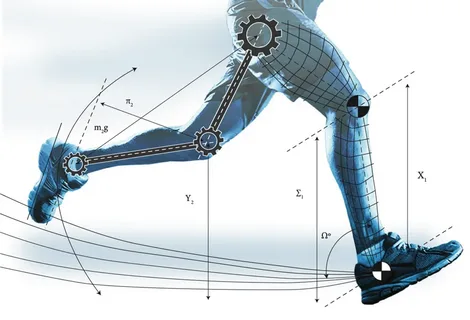Think of biomechanics as the bridge between biology and engineering—it’s the science of movement. In sports, it breaks down every jump, sprint, and kick into measurable data. It was once the secret weapon of Olympic athletes and is now deeply embedded in football.
How Biomechanics Applies to Football
From tracking a striker’s sprinting mechanics to analyzing how a goalkeeper dives, biomechanics is everywhere. It helps clubs decode player motion in a scientific way, making training more effective and reducing injury risks.
Why Top Football Clubs are Obsessed with Biomechanics
Enhancing Player Performance
Top clubs use biomechanics to fine-tune every movement. Cristiano Ronaldo’s leap? Lionel Messi’s balance? Behind those mind-blowing moments is biomechanical optimization that teaches the body to move efficiently.
Injury Prevention and Rehabilitation
Clubs like Liverpool and Arsenal use biomechanical data to spot injury risks before they happen. This allows them to adjust workloads and recovery programs. FIFA’s Medical Research Centre supports these methods for global injury prevention.
Real-Time Data for Tactical Decisions
Data isn’t just for nerds. Managers like Pep Guardiola use live movement data to make tactical tweaks mid-match. Imagine knowing which player is tiring before they show it on the field!
Biomechanical Technologies Used in Football
Motion Capture Systems
Motion capture (or “mocap”) is like giving Iron Man tech to footballers. Cameras track every limb in 3D.
3D Motion Analysis in Training
This tech helps analyze joint angles and limb speeds. It’s especially useful for rehabilitating injuries and perfecting shooting or dribbling mechanics.
Wearable Sensors and GPS Trackers
Players wear GPS vests under their jerseys. These track distance, acceleration, and even the G-force of impacts.
Force Plates and Pressure Mats
Ever wondered how much power goes into a kick? Force plates capture ground reaction forces. They’re key for evaluating balance and power during training.
Smart Insoles and Biomechanical Boots
Boots aren’t just stylish—they’re smart now. These can measure foot pressure, torque, and step patterns in real-time.
Inside Elite Clubs: Biomechanics Labs and Facilities
Case Study: FC Barcelona Innovation Hub
Barça’s Innovation Hub is a playground of tech where biomechanics meets AI. It’s used not just for players but to push global sports science forward.
Case Study: Manchester City’s Biomechanical Strategy
City’s Cityzens Giving project also integrates biomechanics for social impact. Players are analyzed using data-driven tools developed with MIT researchers.
Liverpool FC’s Data-Driven Rehab Models
Liverpool works with the Red Zone data system—using real-time tracking to ensure injured players don’t return too soon.
The Role of Sports Scientists and Biomechanists
Daily Tasks and Workflow
From early-morning tests to late-night video analysis, biomechanists are the hidden MVPs. They assess players, tweak drills, and optimize workloads.
Working with Coaches and Medical Teams
Biomechanists work hand-in-hand with physios, doctors, and trainers. They translate hard data into simple action steps for performance and safety.
How Biomechanics Shapes Football Training Programs
Tailoring Workloads Based on Kinetic and Kinematic Data
Every athlete is unique. Biomechanics allows personalized training regimens—making sure each player is pushed just right.
Correcting Technique with Biomechanical Feedback
Using real-time video feedback, players can see and feel their errors. It’s like having a coach in your pocket.
Youth Academies and Biomechanics
Scouting Talent Through Movement Patterns
Young athletes are now evaluated on how they move—not just how fast or strong they are. This gives a fuller picture of potential.
Early Intervention and Injury Risk Screening
Injury-prone players are flagged early and given tailored programs. This saves careers before they even begin.
Performance Analytics: From Lab to Pitch
Data Visualization for Coaches
Complex graphs are transformed into simple visuals. Coaches can see who’s overtraining or underperforming at a glance.
Translating Metrics into Strategy
Numbers become insights. For instance, knowing a winger cuts sharper to the left can influence your entire match plan.
Fan Engagement and Biomechanics
Augmented Reality and Fan Experiences
Some clubs use AR to show fans how players move. Imagine comparing your sprint to Mbappé’s on a stadium screen!
Educational Content for Tech-Savvy Fans
Web platforms and YouTube channels explain biomechanics in cool, digestible ways—perfect for the TikTok generation.
Challenges in Biomechanical Integration
Cost and Accessibility Issues
Implementing advanced biomechanics technology in football comes with significant financial implications. Establishing a state-of-the-art biomechanics lab equipped with motion capture systems, force plates, and high-speed cameras can be prohibitively expensive, often reaching into the millions. This financial barrier means that only top-tier clubs with substantial budgets can afford such facilities.
For smaller clubs and grassroots organizations, the high costs limit access to these performance-enhancing tools. However, recent advancements are making biomechanics more accessible. For instance, platforms like Motion-IQ offer AI-driven movement analysis using just a smartphone, providing a cost-effective alternative to traditional lab setups.
Additionally, collaborations between sports organizations and academic institutions are helping bridge the gap. The Nora Staeel Evertt Human Performance Lab expanded its facilities with a $200,000 grant, enhancing research and accessibility for broader communities.
Privacy and Data Ethics
The integration of biomechanics in football raises critical concerns about data privacy and ethics. Collecting detailed biometric data—such as movement patterns, heart rates, and injury histories—necessitates stringent data protection measures.
Players’ biometric data is highly sensitive, and its misuse can lead to significant consequences. Issues arise regarding who owns this data, how it’s stored, and who has access. The lack of comprehensive legal frameworks exacerbates these concerns. As highlighted in a Columbia Law School publication, the absence of federal laws regulating biometric data in sports leaves athletes vulnerable to potential privacy breaches.
To address these challenges, organizations like FIFPRO have launched initiatives such as the Charter of Player Data Rights. This charter aims to implement global standards that protect players’ privacy and grant them control over their personal data.
Furthermore, the commercialization of player data without consent has led to legal disputes. The Project Red Card initiative involves over 400 players challenging the unauthorized use of their performance data, emphasizing the need for clear regulations and ethical standards in the use of biometric information.
Read Also Will Artificial Intelligence (AI) Take Over Human Intelligence?
The Future of Biomechanics in Football
AI-Powered Movement Prediction
Imagine a world where your body tells you before it gets hurt. That’s not sci-fi—it’s happening right now in football.
Artificial Intelligence (AI) has become a powerful ally in the biomechanics toolbox. By analyzing thousands of hours of match and training data, AI can now detect patterns that even the sharpest human eye might miss. It learns what “normal” movement looks like for each player and flags any subtle deviations that suggest fatigue, overuse, or poor mechanics—often before an injury happens.
Elite clubs are embedding this tech into training routines. Machine learning models integrate biomechanical inputs like joint angles, stride length, and force distribution, then compare them to past performance and injury history. If something’s off—maybe a midfielder is favoring one leg slightly—coaches get an alert. That’s their cue to tweak a drill, adjust training load, or schedule recovery sessions.
Some clubs go a step further, using predictive AI for substitution decisions during games. Instead of waiting for a player to signal discomfort, the system suggests optimal sub times based on biomechanical stress markers. Talk about playing chess while everyone else is playing checkers!
And as more data gets collected, the smarter these systems become. Expect to see AI not just predict injuries, but also personalize warm-ups, post-match recovery, and even nutrition plans based on movement patterns.
Biomechanics in Women’s Football
For too long, women’s football was treated as an afterthought when it came to biomechanics and performance science. But times are changing—and fast.
Biomechanical research is finally catching up to the specific needs of female athletes. Unlike male players, women face unique challenges, such as a higher risk of ACL injuries. This is due to differences in hip-knee alignment, hormonal fluctuations, and even footwear designs that weren’t originally created for the female anatomy.
Now, clubs and research centers are developing biomechanical tools specifically tailored to female physiology. We’re talking about motion analysis systems that account for anatomical variations, wearable tech calibrated for the female gait cycle, and injury prediction models trained on data from female athletes.
Big names like Chelsea FC Women and the USWNT are pioneering this shift. They’ve partnered with sports science institutions to integrate biomechanical screening into daily routines—helping players train smarter, recover quicker, and extend their careers.
Even youth academies for girls are starting to embed these insights early on. By identifying risks and optimizing movement mechanics from a young age, the next generation of female footballers will be stronger, safer, and more explosive than ever before.
In short, the future is not just inclusive—it’s optimized for everyone.
Conclusion: Why Biomechanics is the Future of Football Excellence
Biomechanics isn’t just a buzzword—it’s the foundation of modern football success. Whether it’s preventing a career-ending injury or helping a striker shave milliseconds off their sprint, biomechanics turns potential into performance. For young athletes, science students, and fans alike, it offers a front-row seat to football’s next evolution.
FAQs
1. What is biomechanics in football?
Biomechanics in football refers to the study of player movement, muscle activity, and joint function to improve performance and reduce injury risk.
2. How do top clubs use biomechanics?
Elite clubs use motion tracking, force plates, and wearable tech to gather and analyze movement data, which helps optimize training and recovery.
3. Is biomechanics only for professional footballers?
Nope! Youth academies, college teams, and even individual athletes now use biomechanical tools to enhance performance and prevent injuries.
4. Can biomechanics really prevent injuries?
Absolutely. By identifying risky movement patterns or asymmetries, clubs can proactively manage workloads and training methods.
5. Where can I learn more about sports biomechanics?
Check out FIFA’s Medical Network, the Barça Innovation Hub, and resources from MIT Sports Lab for cutting-edge insights.




